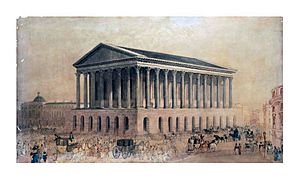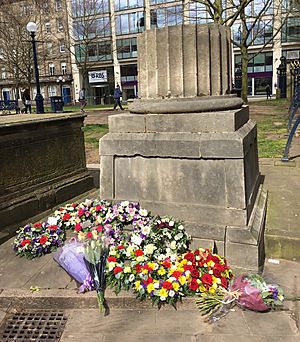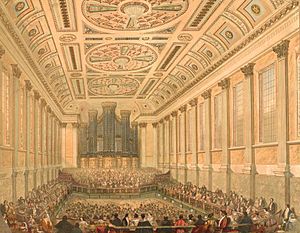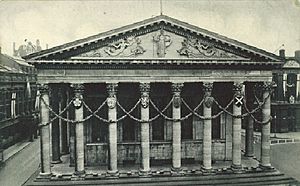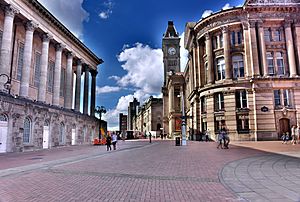Birmingham Town Hall facts for kids
Quick facts for kids Birmingham Town Hall |
|
|---|---|
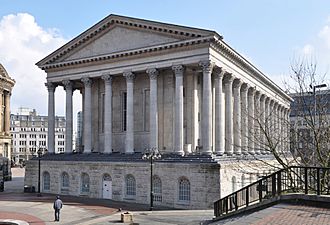
Birmingham Town Hall, March 2009
|
|
| General information | |
| Type | Concert hall |
| Architectural style | Classical |
| Location | Victoria Square |
| Town or city | Birmingham |
| Country | United Kingdom |
| Coordinates | 52°28′47″N 1°54′13″W / 52.4796°N 1.9037°W |
| Current tenants | Performances Birmingham Ltd |
| Construction started | 27 April 1832 |
| Opened | 7 October 1834 |
| Renovated | 1996—2007 |
| Cost | 25,000 Pound sterling |
| Renovation cost | 35 million Pound sterling |
| Owner | Birmingham City Council |
| Design and construction | |
| Architect | Joseph Hansom & Edward Welch |
| Main contractor | Thomas & Kendall |
| Renovating team | |
| Architect | Rodney Melville Partners |
| Renovating firm | Wates Group |
| Other information | |
| Seating capacity | 1,086 |
|
Listed Building – Grade I
|
|
| Official name: Birmingham Town Hall | |
| Designated: | 25 April 1952 |
| Reference #: | 1343161 |
Birmingham Town Hall is a concert hall and venue for popular assemblies opened in 1834 and situated in Victoria Square, Birmingham, England. It is a Grade I listed building.
The hall underwent a major renovation between 2002 and 2007. It now hosts a diverse programme of events including jazz, world, folk, rock, pop and classical concerts, organ recitals, spoken word, dance, family, educational and community performances, as well as annual general meetings, product launches, conferences, dinners, fashion shows, graduation ceremonies and broadcasts.
History
Two sites were considered by the Birmingham Street Commissioners for the construction of a concert hall in the city; Bennetts Hill and the more expensive Paradise Street site. The latter was chosen and a design competition was launched which resulted with the submission of 67 designs including one by Charles Barry, whose design for the King Edward's School on New Street was then under construction.
Joseph Hansom, of Hansom cab fame, and Edward Welch were chosen as the architects and they expressed that they expected the construction cost to be £8,000 (equivalent to £600,000 in 2021), . Hill of London was hired to build the 6,000 pipe organ for £6,000. Construction began on 27 April 1832 with an expected completion date of 1833. However, Hansom went bankrupt during construction, having tendered too low. The contractors were also losing money. Three guarantors donated money for the building; W. P. Lloyd, John Welch and Edward Tench. With the injection of this money, the building was successfully opened for the delayed Music Festival on 7 October 1834, despite the building still being unfinished.
During construction, on 26 January 1833, two workers were killed when a 70-foot crane constructed to install the roof trusses broke and the pulley block failed. John Heap died instantly and Win. Badger died a few days later from his injuries. They were buried in St Philip's churchyard and a memorial, consisting of a pillar base made by one of the workmen for the Town Hall, was dedicated to them. Architect Charles Edge was commissioned in 1835 to repair weaknesses to the design of the building. He was also commissioned for the extension of the building in 1837 and again in 1850.
Charles Dickens gave public readings here to raise money for the Birmingham and Midland Institute, and Mendelssohn's Elijah and Elgar's The Dream of Gerontius both received their premieres in the hall. Sir Arthur Sullivan's "Overture di Ballo" was also premièred here in August 1870, as part of the Triennial Musical Festival which commissioned new works for every season. The hall was the home venue for the City of Birmingham Symphony Orchestra from 1918 until 1991 when they moved to Symphony Hall.
In November 1880, the Hall was filled to capacity for a Birmingham public protest meeting in support of Revd. Richard Enraght, Vicar of Holy Trinity, Bordesley, who was imprisoned in Warwick Prison under the Disraeli Government's Public Worship Regulation Act.
Popular music has also featured, and in the 1960s and 1970s, headline acts such as Buddy Holly, The Beatles, Led Zeppelin, Queen, Pink Floyd, Black Sabbath, The Rolling Stones & Bob Dylan appeared.
On 9 August 1902, the town hall, along with the council house, was illuminated in celebration of the coronation of King Edward VII and Queen Alexandra. It was illuminated again on 22 June 1911 for the coronation of King George V. In 1901, it was the scene of rioting on the occasion of a visit by David Lloyd George.
It featured prominently in the 1967 Peter Watkins film Privilege and doubled for the Royal Albert Hall in 1996s Brassed Off.
In 1937, as part of the celebrations for the Coronation of George VI, the Town Hall was regaled in the various Arms of the Lord of the Manor of Birmingham since 1166 and each column festooned with garlands. The pediment also had images of Britannia, supported by mermaids, which were sculpted by William Bloye. This decorative scheme for the Town Hall and the whole of the city was devised by William Haywood, Secretary of The Birmingham Civic Society.
Renovations
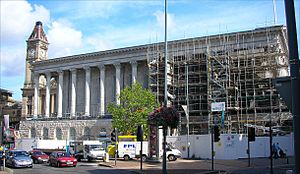
The Hall closed in 1996 for a £35 million (equivalent to £47.3 million in 2021) refurbishment, undertaken by Wates Construction, that has seen the Town Hall brought back to its original glory with its 6,000-pipe organ still in place. The project was funded by £18.3 million from Birmingham City Council, £13.7 million from the Heritage Lottery Fund and £3 million from the European Regional Development Fund. The upper gallery, which had been added in 1926–27, was removed, restoring the interior of the hall to an approximation of its original condition.
The Birmingham City Organist, Thomas Trotter, performed a piece of music to a group of school children in 2005 after the majority of the organ had been cleaned. However, the organist and the children all had to wear hard hats as the risk of falling debris remained. He had played the organ each month from the hall's closure to 2005, thus ensuring that it was maintained in playable condition. The hall is now managed alongside Symphony Hall, by the registered charity Performances Birmingham Limited. At 1,100, the seating capacity is about half that of Symphony Hall.
It reopened for concerts on 4 October 2007, and was officially reopened on 22 April 2008 by TRH The Prince of Wales and The Duchess of Cornwall.
During the years of refurbishment the side of the Town Hall facing Victoria Square was hidden by giant advertising sheets, a giant advent calendar, and during the 2002 FIFA World Cup a large outside television screen that was used to broadcast live matches from Korea and Japan. Although the television screen was only temporary, another "Big Screen" was erected on the corner of the building in Chamberlain Square facing Birmingham Central Library, which broadcast live from the television channel BBC One. The BBC Big Screen controversially sited next to the rear of the building, facing Chamberlain Square, has been removed.
Architecture
Built in brick, created in Selly Oak, and faced with Penmon Anglesey Marble presented to the town by Sir R. Bulkeley, proprietor of the Penmon quarries, the hall is modelled on the Temple of Castor and Pollux in Rome. Some limestone was used in its construction and fossils of plants and animals are visible. In the late 1980s and early 1990s, the front arches were glazed to create an entrance foyer.
Pipe organ
The town hall is famous for its concert pipe organ. Originally installed in 1834 by William Hill & Sons with 4 manuals and 70 stops, this was subject to many rebuilds and alterations, all by William Hill, until a restoration by Willis in 1932. By 1956 the organ had been enlarged to 90 stops.
The most recent restorations in 1984 and 2007 have been by Manders of London.
A current specification of the organ can be found on the National Pipe Organ Register.
Further pictures
- Images of England — details from listed building database (217694)
See also
 In Spanish: Ayuntamiento de Birmingham (edificio) para niños
In Spanish: Ayuntamiento de Birmingham (edificio) para niños


